Francesco Laurana - Frane Vranjanin 1420-1502 Croatian Renaissance sculptor and his Lost Princess
http://www.croatia.org/crown/articles/10219/1/Francesco-Laurana---Frane-Vranjanin-1420-1502-Croatian-Renaissance-sculptor-and-his-Lost-Princess.html
By Prof.Dr. Darko Zubrinic
Published on 01/9/2012

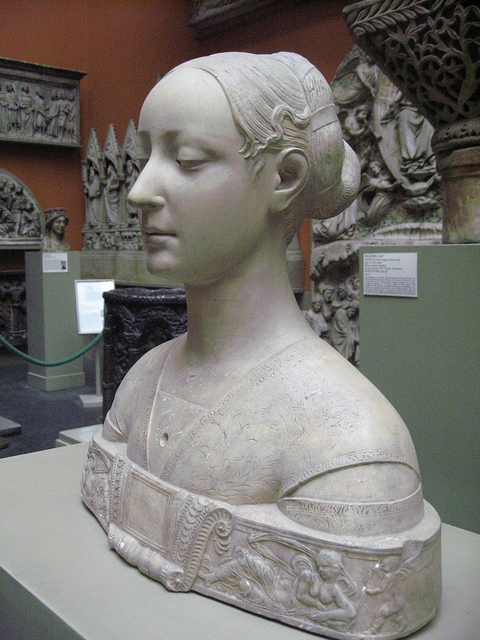
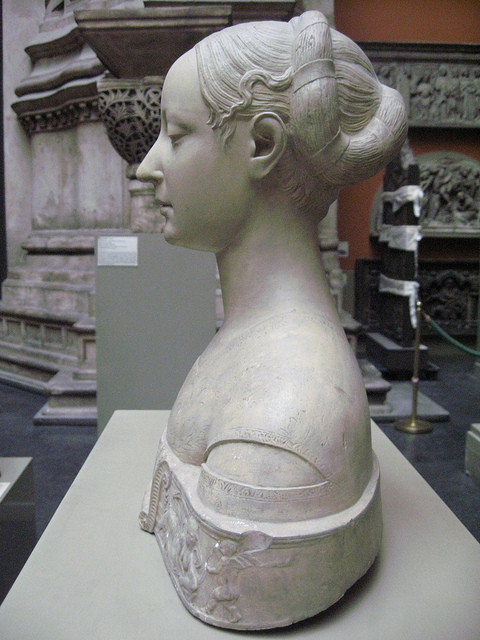
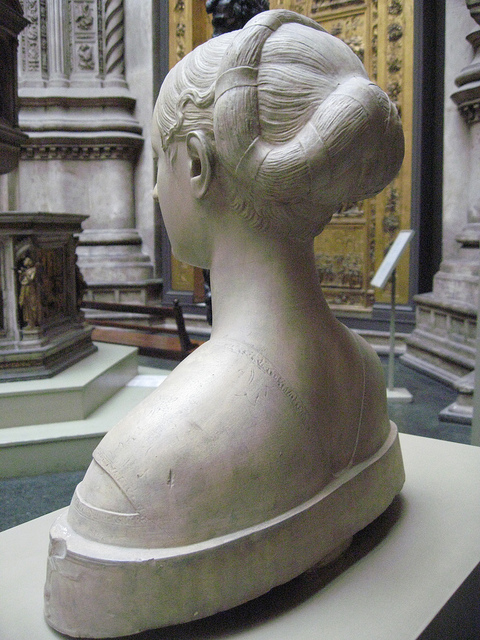
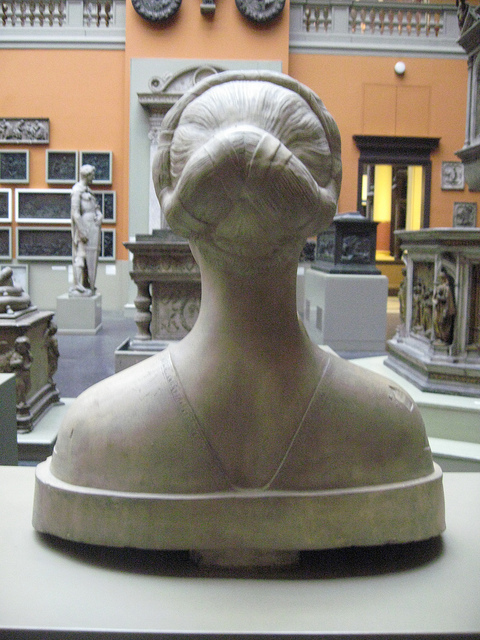

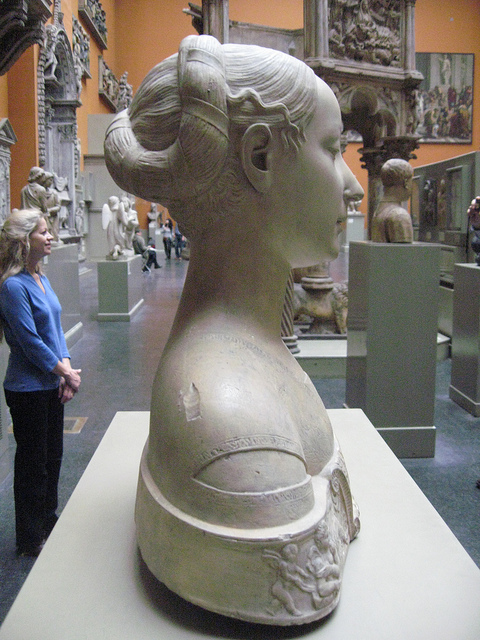
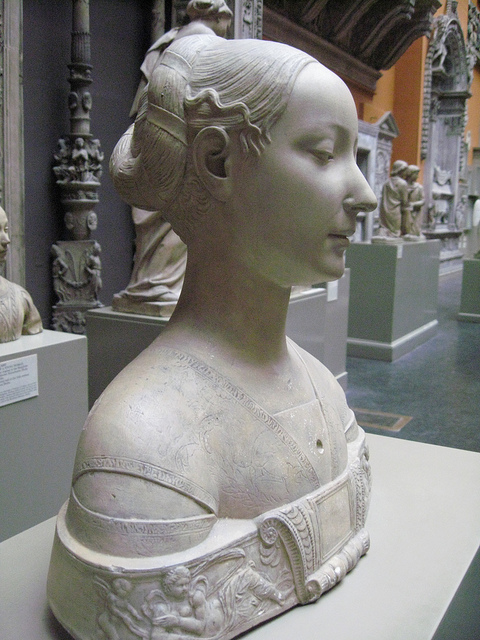

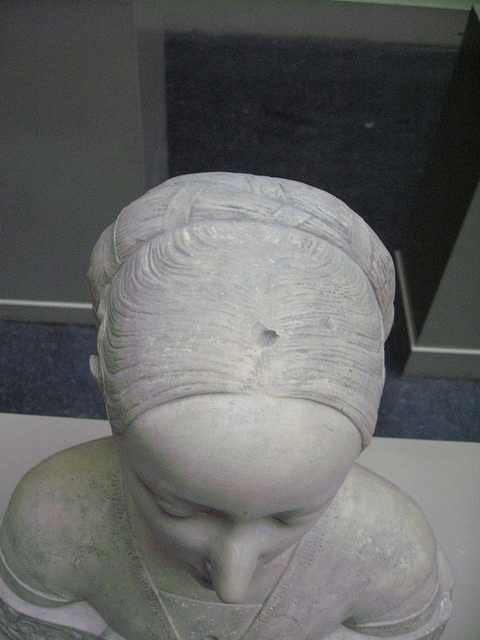
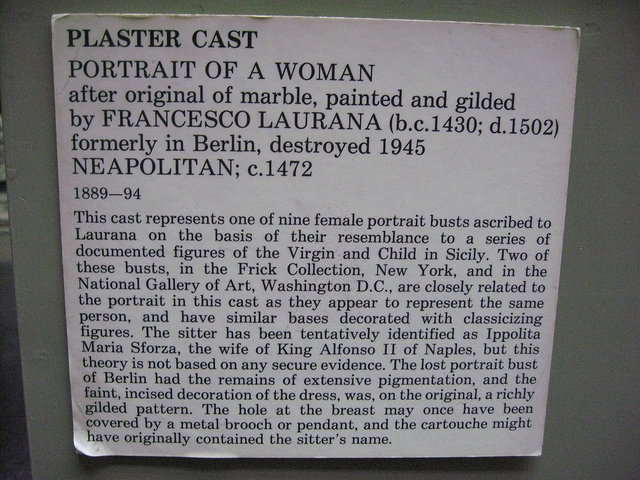




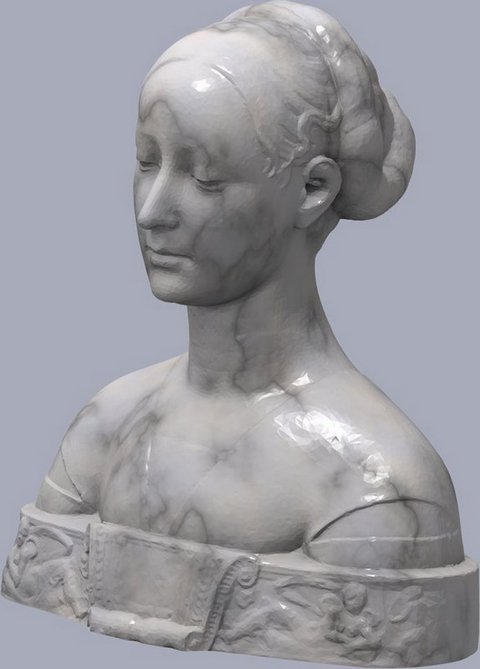
 | Frane Vranjanin or Francesco Laurana was born in Vrana around 1420, near Zadar. Laurana’s female busts, after they had been finally correctly attributed to him several decades before, by at the turn of 20th century came into the focus of interest of greatest German and French scholars. He is considered to be the greatest non-Tuscan and non-Venetian sculptor active in Italy in 15th century With this article we mark 510 years since his death in 1502 in France (Avignon or Marseille). |
Born around 1420 in Vrana near the city of Zadar in Croatia

Frane Vranjanin or Francesco Laurana (about 1420-1502), female bust,
plaster cast kept in V&A (Victoria and Albert Museum) in London, Great Britain
plaster cast kept in V&A (Victoria and Albert Museum) in London, Great Britain
| “If Laurana were Leonardo (…) what would art historians think about his female busts?” – asked German architect and art history professor Fritz Burger (1877-1916) in his monograph on Croatian renaissance sculptor Frane Vranjanin – known as Francesco Laurana. He was born in Vrana, near Zadar, Croatia. Laurana’s female busts, after they had been finally correctly attributed to him several decades before, by at the turn of 20th century came into the focus of interest of greatest German and French scholars. Peter Tusco, for example, called Laurana “the greatest non-Tuscan and non-Venetian sculptor active in Italy in 15th century” (prof. dr. Ivana Prijatelj). John Pope Hennesy, one of the foremost authority on Italian renaissance, praised Laurana’s female busts as “some of the most sensitive achievement of the fifteenth century”. Having lived and worked in Dalmatia, Rome, Naples, Apulia, Sicily and Provence, Laurana did not belong in any of the regional schools. He was actually a link between Italian and French courts of his time. Source Francesco Laurana and 19th century academies |

Source www.flickr.com, as well as the photos below










Photos by Frederick Muller at A&V, London


The original bust, destroyed in Berlin during the WWII.

Frane Vranjanin - Francesco Laurana, bust from the Louvre in Paris.
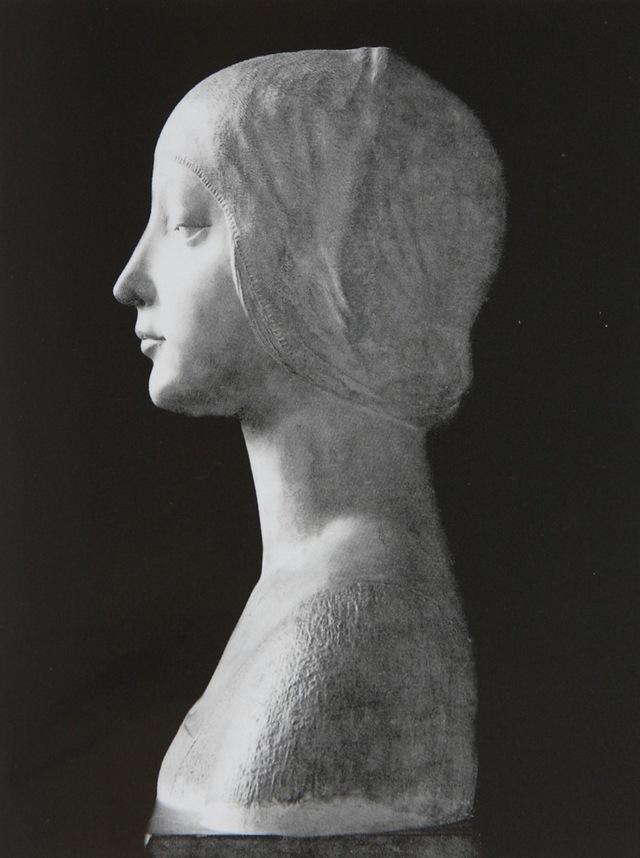

The same bust by Francesco Laurana kept in Louvre
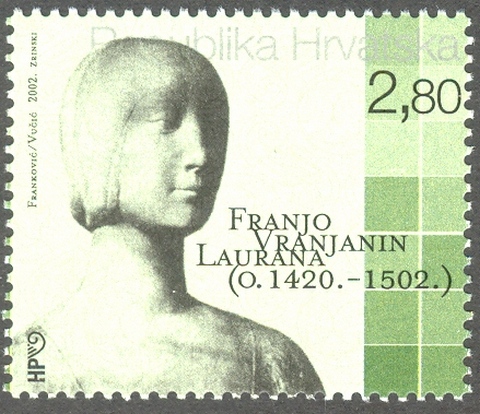

Republic of Croatia commemorated 500 years since the death of Franjo Vranjanin Laurana by issuing this postage stamp in 2002.
HP = Hrvatska pošta = Croatian post
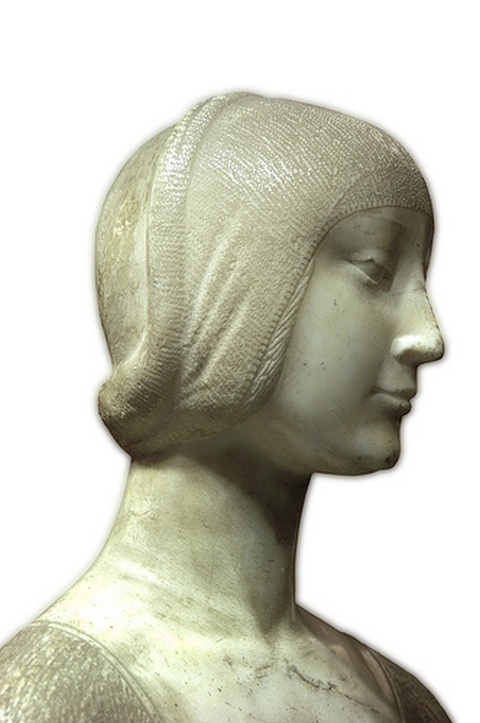
HP = Hrvatska pošta = Croatian post
| Marke su izdane u arcima od 20 maraka, a izdane su i dvije omotnice prvoga dana (FDC). 2,80 kn - 500. obljetnica smrti Franje Vranjanina Laurane Hrvatski renesansni kipar Franjo zvan Vranjanin, jer je rođen (oko 1420. godine) u mjestu Vrana kraj Zadra, radio je uglavnom u južnoj Italiji i južnoj Francuskoj, gdje je i umro 1502. godine. Iako hrvatskoga podrijetla, kao i glasoviti ranorenesansni arhitekt Lucijan Vranjanin, Franjo je upisan u europsku povijest likovnih umjetnosti pod talijanskim imenom Francesco Laurana (=della Vrana). Nema podataka o njegovoj mladosti i školovanju, a prvo što o njemu znamo jest da sudjeluje s grupom istaknutih kipara na izvedbi velikih projekata napuljskog vojvode Alfonsa Aragonskog. Na velikom vojvodinom renesansnom dvoru - tvrđavi u Napulju, s ogromnim i za to doba neuništivim okruglim kulama, Franjo Vranjanin je 1452. godine, zajedno s kiparima G. Sagrero, Petrom iz Milana, Iziaijom iz Pise i drugima, izveo monumentalni kameni slavoluk raskošno opremljen reljefima i skulpturama. Slavoluk uokviruje ulaz u središnje dvorište, a ima u prizemlju veliki luk s po dva stupa sa svake strane, zatim jedno široko polje reljefnih prikaza, pa nad njim polukružno uokvirenu ložu i na vrhu skulpture u nišama i završni obli zabat. Brojni visoki reljefi sa stotinama likova raspoređeni u savršenoj renesansnoj perspektivi, skladnih oblika i proporcija prikazuju prizore iz vojvodina života. Po mišljenju nekih povjesničara umjetnosti (R. Rolfs) Franjo Vranjanin je zamislio slavoluk i izveo najbolje dijelove, dok mu neki drugi autori pripisuju znatno manje. Zatim boravi u Francuskoj (1461-1464), u Provansi i radi na dvoru poznatog humaniste i pokrovitelja umjetnosti kralja Renea, reljefne medalje u tragu ranorenesansnog medaljera Pisanella: s likom kralja Renea i kraljice, dvorske lude i Charlesa Anjou, Louisa XI. i drugih. Nakon toga radio je na Siciliji, u Palermu i Noto (1467-1471), pa ponovno u Napulju kipove Bogorodica i portretna poprsja princeza na aragonskom dvoru. Od 1474. djeluje u Francuskoj, u Marseillesu, Tarasconu i Avignonu, gdje i umire 1502. godine. Najznačajnija Vranjaninova djela su portretna mramorna ženska poprsja u kojima je dosegao najviši umjetnički domet, a ona su mu osigurala opće priznanje i najveću i do danas trajnu slavu. U galeriji njegovih ženskih portreta ističu se poprsja princeza Beatrice Aragonske, Eleonore Aragonske, Battiste Sforze i drugih, što se osim u Palermu, nalaze u najpoznatijim svjetskim muzejima Beča, Berlina, Pariza, New Yorka i drugdje. Kipar Francesco Laurana i arhitekt Luciano Laurana, dva brata Vranjanina, nezaobilazna su imena rane renesanse 15. stoljeća, dakle u doba njezina prvog uspona i cvata. Bez njihova se djela i udjela ne može zamisliti ni napisati povijest renesanse u Italiji, a time ni europske renesanse. Svojim talijaniziranim imenima bili su sasvim utopljeni u talijansku umjetnost i tek se u novije doba više priznaje i ističe njihovo dalmatinsko, odnosno hrvatsko podrijetlo. No, još će mnogo trebati raditi, objavljivati studije i knjige na stranim jezicima, dok jednostavna činjenica o dvojci Hrvata, koji su iz istog malog mjesta u Dalmaciji, kraj Zadra, došli u Italiju i tamo ostvarili osebujna i izuzetno vrijedna djela, bude dovoljno poznata i zaista jedinstveno priznata od svih. Source www.posta.hr | The stamps have been issued in 20-stamp sheets, and two First Day Covers (FDC) have also been issued. 2.80 HRK - 500th Anniversary of the death of Franjo Vranjanin Laurana The Croatian Renaissance sculptor Franjo called Vranjanin, due to the fact that he was born in the small place Vrana near Zadar (round 1420), mostly worked in southern Italy and southern France where he died in 1502. Though Croatian by origin, like the famous architect Lucijan Vranjanin (1425-1479), Franjo has been entered in the European history of visual arts under the Italian name Francesco Laurana (derived from della Vrana). There are no available data on his youth and schooling, and the first thing we learn about him is that he participated, together with a group of eminent sculptors on the execution of the great projects of Alfonso Aragon, the Duke of Napoli. In 1452, at the Duke's huge Renaissance court - the fortress of Napoli, with its huge, and at that time indestructible round fortresses, Franjo Vranjanin executed, together with the sculptors G.Sagrero, Pietro from Milan, Isaiah from Pisa and others, a monumental stone triumphal arch luxuriously fitted with reliefs and sculptures. The arch forms a frame to the doorway of the central courtyard, and there is a large arch resting on two pillars on both sides on the lower level, then a wide area of relief scenes, and above it a semicircular framed-in loggia and on top sculptures in niches and the closing round gable. Numerous high reliefs with hundreds of figures arranged in perfect Renaissance perspective, with harmonious forms and proportions represent scenes from the Duke's life. According to some art historians (R.Rolfs) it was Franjo Vranjanin who designed the whole arch and executed the best parts, while other authors attributed a lesser part of the work to him. Afterwards Vranjanin lived in France (1461-1464), in Provence, and worked at the court of the well-known humanist and patron of arts, King Renee. He produced relief medallions in the manner of the early-Renaissance medallist Pisanello: the images of the king and queen, the court jester and Charles Anjou, Louis XI and others. After that he went to work in Sicily, in Palermo and Noto (1467-1471) then again in Naples where he sculpted the figures of Mother of God and portrait busts of princesses at the court of Aragon. Since 1474 he worked in France, in Marseilles, Tarascon and Avignon where he died in 1502. The most important works of Vranjanin are the portrait marble busts where he achieved the highest artistic attainment, and it was these that secured him general appreciation and greatest glory lasting up to our days. In the gallery of his female portraits, outstanding places are taken by the busts of princesses Beatrice of Aragon and Eleanor of Aragon, Battista Sforza and others. These busts can be found in Palermo, but also in the most famous museums of the world, in Vienna, Berlin, New York and elsewhere. His sculptures are characterized by a clear contour and smooth surface, and extremely simplified shapes, without any superfluous naturalistic details favoured by the Gothic sculpture before his time. The heads, like marble eggs, are posed on the perfect cylinder of the neck that grows up from the softly rounded shoulders. By these characteristics Vranjanin is the only artist among the early-Renaissance sculptors who has come closest to the ideal of pure stereometric form, and this makes him related to some aspirations of contemporary abstract sculpture. Light glides quietly along the perfectly smoothed marble and softly blends into transparent shadows. There is no movement nor restless surface, no contrast play (and powerful clashes) of light and shadow typical of the former Gothic art that would again become the main feature of Baroque sculpture. Vranjanin's sculptures can be compared to the equally perfect, ideally shaped figures on the frescos and on the paintings of the famous Piero della Francesca, who worked at the same time in central Italy (Arezzo, Urbino). The sculptor Francesco Laurana and architect Luciano Laurana, two brothers Vranjanin, are unavoidable names of the early Renaissance of the 15th century, i.e. at the time of its first rise and flourish. Without their work and their share in the art one could not imagine nor write the history of the Renaissance in Itraly, and consequently the history of European Renaissance. Their Italianized names have made them immersed in Italian art and it is only recently that their Dalmatian, i.e. Croatian origin is acknowledged and emphasized. But there is much work ahead, many studies and books to be published in foreign languages for the simple truth about the two Croats who have started from the same small place near Zadar and gone to Italy to produce distinctive and exceptionally valuable masterpieces, to be made known and really universally acknowledged by everybody. We have to mention that the greatest project of Lucijan Vranjanin is the palace of the Duke Francesco Montefeltro in Urbino with the famous Renaissance atrium and loggias open to the landscape. This commemorative stamp of the Croatian Post will contribute to the mentioned aim of acknowledgment and appreciation of the Croatian contribution to the Italian and French Renaissance. Such activities should be systematically continued in order to encourage memories of names and evaluate works of art of many artists of Croatian origin - in Italy usually referred to as "Schiavoni" (Slavs) who have paid a permanent and irreplaceable contribution to the culture and art of the Italian and French art, the Hungarian art present at the court of King Mathew Corvinus, and generally to the whole of European Renaissance art. Source www.posta.hr |


Frane of Vrana - Francesco Laurana: Ipolita Maria Sforza
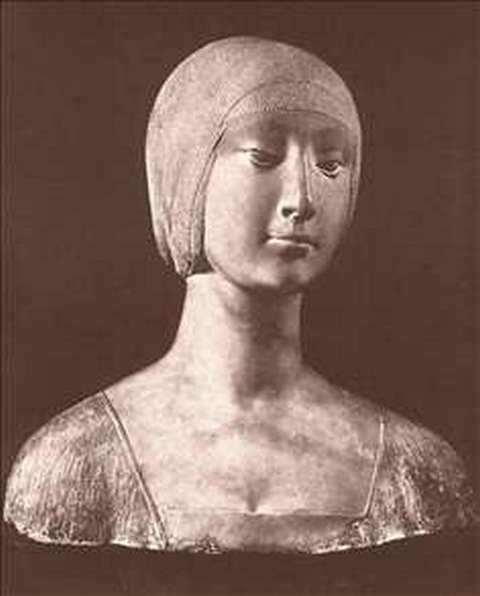
Franjo Vranjanin: Isabella of Aragonia
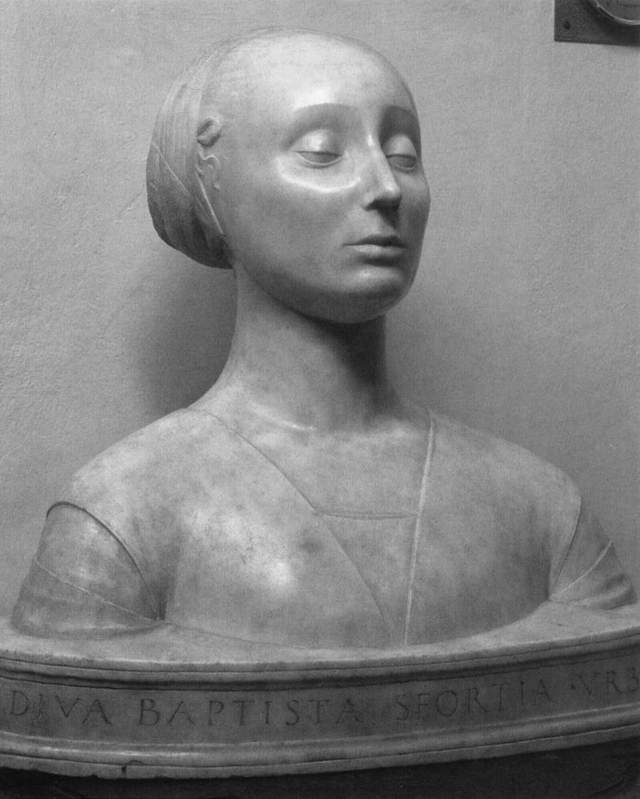
Francesco Laurana: bust of Battista Sforza
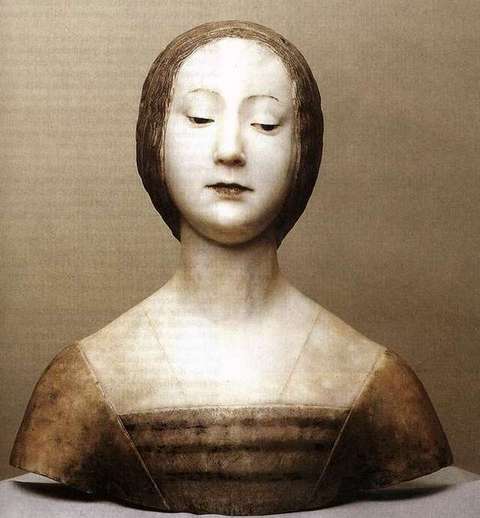
Francesco Laurana: Bust of a lady, Kunsthistorisches Museum, Vienna, Austria

Francesco Laurana - Franjo Vranjanin: Portrait Bust of Beatrice of Aragon, ca. 1474–75. Inscribed on tablet: DIVA BEATRIX / ARAGONIA
The Frick Collection, New York. Source www.alaintruong.com.

Franjo Vranjanin - Francesco Laurana: Triumphal Arch of Alfonso I, Castelnuovo, Naples, Italy
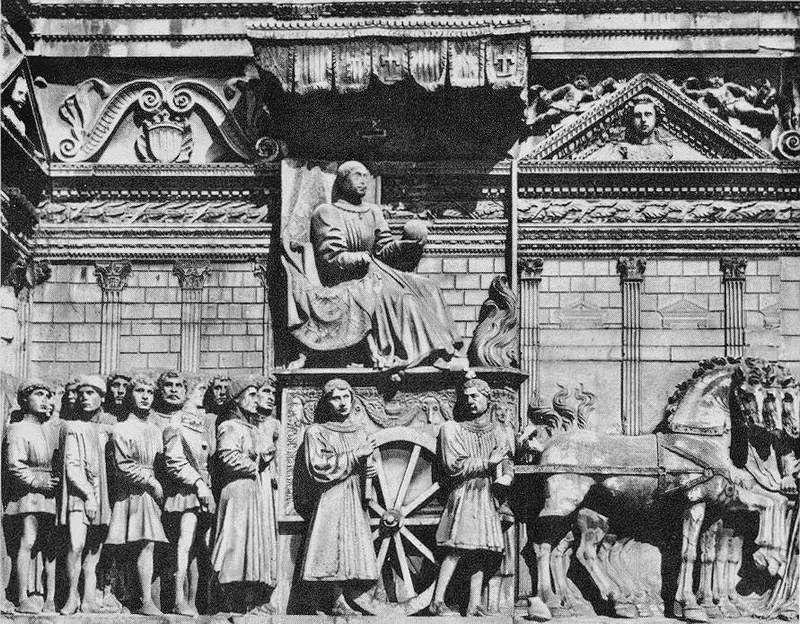
Franjo Vranjanin - Francesco Laurana: Alfonso of Aragon in Triumph with his Court, Castelnuovo, Naples, Italy;
a detail from the lower part on the preceding photo.
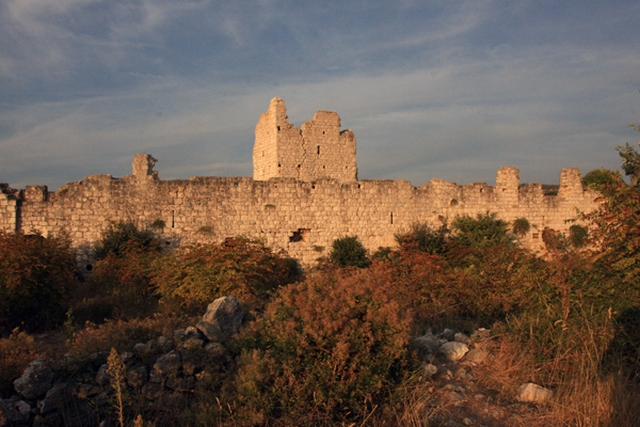
Vrana not far from the Lake of Vrana (Vransko jezero), near the city of Zadar, Croatia,
where Frane Vranjanin - Franceso Laurana was born. Photos courtesy of Julija Vojković, Zagreb.


Franjo Vranjanin: Isabella of Aragonia

Francesco Laurana: bust of Battista Sforza

Francesco Laurana: Bust of a lady, Kunsthistorisches Museum, Vienna, Austria

Francesco Laurana - Franjo Vranjanin: Portrait Bust of Beatrice of Aragon, ca. 1474–75. Inscribed on tablet: DIVA BEATRIX / ARAGONIA
The Frick Collection, New York. Source www.alaintruong.com.

Franjo Vranjanin - Francesco Laurana: Triumphal Arch of Alfonso I, Castelnuovo, Naples, Italy

Franjo Vranjanin - Francesco Laurana: Alfonso of Aragon in Triumph with his Court, Castelnuovo, Naples, Italy;
a detail from the lower part on the preceding photo.

Vrana not far from the Lake of Vrana (Vransko jezero), near the city of Zadar, Croatia,
where Frane Vranjanin - Franceso Laurana was born. Photos courtesy of Julija Vojković, Zagreb.

Formated for CROWN by prof.dr. Darko Žubrinić
Distributed by www.Croatia.org . This message is intended for Croatian Associations/Institutions and their Friends in Croatia and in the World. The opinions/articles expressed on this list do not reflect personal opinions of the moderator. If the reader of this message is not the intended recipient, please delete or destroy all copies of this communication and please, let us know!
Distributed by www.Croatia.org . This message is intended for Croatian Associations/Institutions and their Friends in Croatia and in the World. The opinions/articles expressed on this list do not reflect personal opinions of the moderator. If the reader of this message is not the intended recipient, please delete or destroy all copies of this communication and please, let us know!